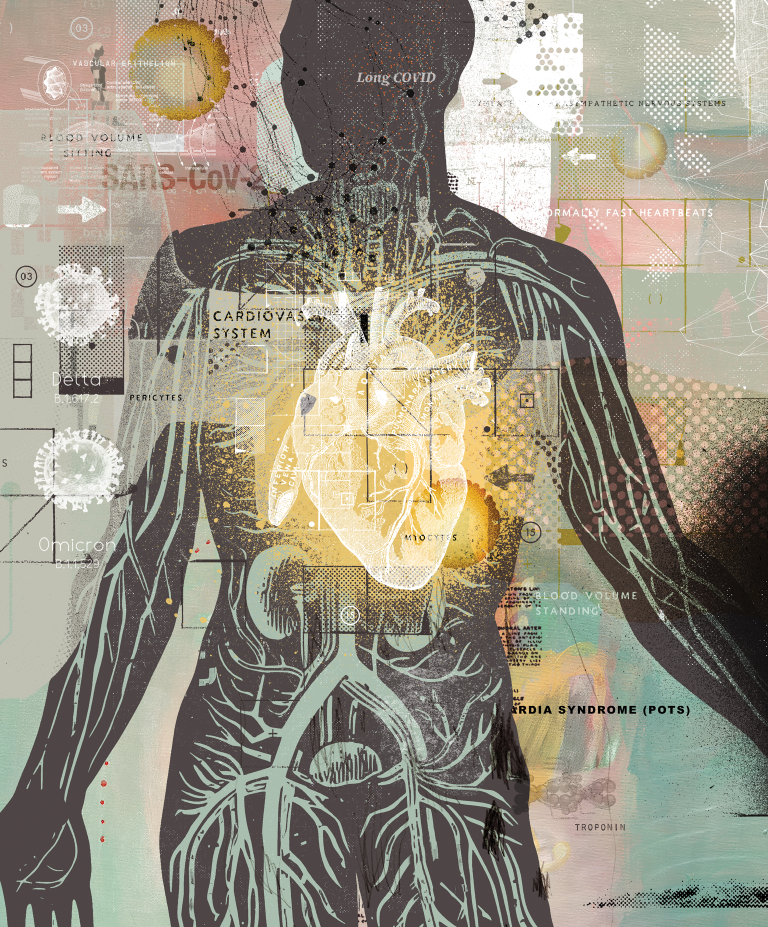COVID’s Damage Lingers in the Heart
Researchers increasingly find that the effects of infection by SARS-CoV-2 extend to the cardiovascular system
- 11 min read

As the COVID-19 pandemic was getting underway in early 2020, doctors in Wuhan, China, began to report that many patients hospitalized with the disease had cardiac injuries. Heart attacks were frequent, especially in patients with underlying risk factors, and there were numerous cases of myocarditis, which occurs when the heart’s muscle layers become inflamed. Roughly a quarter of patients with severe COVID-19 had elevated blood levels of troponin, a protein marker for cardiac damage.
This evidence altered how COVID-19 was viewed; previously considered primarily a form of pneumonia, it now took on a coronary dimension. “We began to understand that it’s also a cardiovascular disease,” says Peter Libby, the Mallinckrodt Professor of Medicine at HMS and a cardiologist at Brigham and Women’s Hospital.
Hospitalizations and deaths from COVID-19 have since fallen off, the result of widespread vaccinations and the population’s growing immunity against severe disease. But SARS-CoV-2, the coronavirus that causes COVID-19, is still with us, along with the risk it poses to heart health, especially in people with blocked arteries, hypertension, diabetes, and other predisposing factors. Millions of people who recover from COVID-19 have gone on to develop lingering cardiovascular symptoms, including abnormal heartbeats, dizziness, and shortness of breath.
The number of COVID-19 cases is once again spiking — and the coronavirus continues to evolve. The latest omicron variant, BA.2.86, has more than thirty mutations that could allow it to evade the immune system’s defenses. Given the ongoing threat, research into COVID-19’s cardiovascular effects “remains vitally important,” says Anne-Marie Anagnostopoulos, a cardiologist and an HMS instructor in medicine at Beth Israel Deaconess Medical Center. “We need a greater understanding of the associated pathophysiology to develop better treatments.”
Heart ills resulting from COVID
In most people — especially those who’ve been vaccinated — COVID-19 produces flu-like symptoms that typically resolve within a few days or weeks. But other people progress to a second, and more dangerous, phase of the disease, as pro-inflammatory proteins called cytokines proliferate in the blood. During this so-called cytokine storm, the immune system becomes hyperactive, “causing a different set of problems,” says Dara Lee Lewis, MD ’92, an HMS instructor in medicine at Brigham and Women’s and director of noninvasive testing and co-director of the Women’s Cardiology Program at the Lown Cardiology Group in Boston. “Patients can develop weakened heart muscles, low oxygen levels, blood clots, fluid in the lungs — problems that may require hospitalization.”
We need a greater understanding of the associated pathophysiology to develop better treatments.
More importantly, pre-existing cardiac risk factors, such as coronary artery disease and obesity — which can predispose patients to metabolic inflammation — raise the likelihood for poor outcomes. People with vulnerable hearts, Lee Lewis explains, are more likely to succumb to COVID-19 complications than others who do not have these risk factors. In a worst-case scenario, patients could experience a type 1 myocardial infarction, which is a heart attack caused when a blood clot blocks flow in the arteries.
But COVID-19 patients are also unusually prone to a different type of heart attack called a type 2 myocardial infarction. In these cases, the problem isn’t a blockage in the arteries, but rather a mismatch between oxygen supply and oxygen demand. Fever and inflammation accelerate heart rate and increase metabolic demands on many organs, including the heart. If infected lungs are incapable of effectively exchanging oxygen and carbon dioxide, then stressed hearts might suffer damage due to insufficient oxygen.
Lee Lewis says that early in the pandemic, myocarditis was also a major concern, especially for student athletes. “These kids didn’t need to just go back to work and life,” she says. “They needed to get back to competitive play.” Some students she cared for who had been sick with COVID-19 showed up with chest pain, racing hearts, shortness of breath, and evidence of myocarditis on magnetic resonance imaging.

Studies from around the world were reporting that up to one-third of patients who had recovered from COVID-19 also showed evidence of asymptomatic myocarditis on imaging studies. This was troubling, since post-viral myocarditis is a known cause of sudden cardiac death in athletes. “We worried that many of our student athletes would be unable to return to competitive play,” Lee Lewis says. Fortunately, the asymptomatic cases turned out to be uneventful, and the affected students made full recoveries. “Asymptomatic myocarditis wasn’t as big an issue as we initially feared it would be,” Lee Lewis adds. “So, we stopped doing MRIs on everyone who walked in the door.”
A push to understand SARS-CoV-2
That COVID-19 could be so closely associated with heart health wasn’t entirely unexpected. Scientists already knew that other types of infections, such as flu and bacterial sepsis, can amplify cardiac risk factors. It’s not uncommon for older people to have inactive plaques in coronary arteries. The plaques can be destabilized by a localized inflammatory response to remote infections. COVID-19 put a spotlight on these connections and led to greater awareness of the interplay between infections and cardiac disease.
But as an unknown virus, SARS-CoV-2 raised many new questions. One example — whether the virus infects myocytes, the cells responsible for heart contractions — “was initially a big issue,” Libby says.
Research has since shown that myocytes for the most part escape infection. Instead, SARS-CoV-2 damages the heart indirectly by unleashing inflammatory reactions that affect cardiovascular functioning. Upon invading the body, SARS-CoV-2 latches onto cells studded with receptors that are susceptible to the coronavirus spike protein. The spike protein is key to the virus’s infectivity. Once the spike protein is docked to cell-based receptors, it acts to allow SARS-CoV-2 to enter a cell.
Respiratory epithelial cells are considered to be key targets of infection, as are pericytes, which are cells that wrap around capillaries. When infected by the virus, these cells release cytokines that, in turn, act on other cell types that collectively form the interior lining of all blood vessels in the body. This lining, known as the vascular endothelium, “can be thought of as an organ in and of itself,” Lee Lewis says. “The endothelium has a huge job in preventing inappropriate blood clots and allowing blood vessels to constrict and dilate when they normally should.”
Normally, the endothelium keeps blood flowing in a liquid state. But when cytokines activate endothelial cells, the cells transition to a defensive posture: they mobilize macrophages and other immune cells and release molecules that promote blood clotting.
“Cytokines speak to cells throughout the body,” explains Jeremy Luban, a professor at UMass Chan Medical School who also serves on the executive committee of the Massachusetts Consortium on Pathogen Readiness, an HMS-led multi-institutional effort to slow the spread of COVID-19 and prepare for future pandemics. “And among the cells that may be listening are endothelial cells, which constantly have to monitor for coagulation and tissue damage states and induce actions like clotting to stop bleeding and other measures to prevent harm to tissues.”
But blood clots can be lethal. They can, for instance, obstruct arteries feeding the brain. During the pandemic’s early months, arterial blockages were implicated in strokes in numerous patients, even in young people without predisposing risk factors. Autopsies of patients who died from COVID-19 revealed clots throughout the body and evidence of multiple organ failure. Up to one-third of patients hospitalized with COVID-19 were shown to have myocardial injuries that Libby attributes to microvascular clots and endothelial dysfunction, among other conditions.
POTS and viral infection
Microvascular damage has also been implicated in the long-term symptoms that now constitute a growing focus of COVID-19 research. “Even five months after the acute phase of the illness, we can detect these disturbances,” Libby says. He adds that answers to the mystery of what causes long COVID may be found in microvascular dysfunction.
Bruce Levy, the Parker B. Francis Professor of Medicine at HMS and a co-founder of Brigham and Women’s COVID Recovery Center, agrees. The fact that microvessels are present throughout the body, Levy says, might explain why long COVID has been associated with more than 200 symptoms affecting nearly every organ. Brain fog and the confusion and forgetfulness that attends it, for instance, might result from inflammation’s effects on blood vessels in the central nervous system, while long-term cardiovascular symptoms might arise from inflammation in the small vessels leading to and surrounding the heart.
A paper that appeared in August 2023 in Nature Medicine reported an extensive analysis of health care data collected by the U.S. Department of Veterans Affairs during a two-year follow-up of veterans who survived the first thirty days of a SARS-CoV-2 infection and data from a control cohort that had not shown evidence of infection. The study looked at risk of death, hospitalization, and pulmonary and nonpulmonary sequelae. Its findings showed that cardiovascular problems sometimes linger even in people who were never hospitalized for COVID-19. Levy, however, points out that severe initial disease is still the best predictor of long-term symptoms.
POTS is something that we need to be on the lookout for. Many people suffer with it for weeks or months before getting a diagnosis.
Among the more common lingering problems — affecting up to one-third of all patients with long COVID — is postural orthostatic tachycardia syndrome (POTS), which causes the heart to beat abnormally fast. POTS can be diagnosed if a patient’s standing heart rate test measures a sustained increase of at least 30 beats per minute that persists for ten minutes or more after a patient stands. In many patients with POTS, standing heart rates exceed 120 beats per minute. People who have the condition often feel dizzy, fatigue easily, have trouble exercising, and are prone to fainting.
“POTS is something that we as cardiologists, friends, and neighbors need to be on the lookout for,” Lee Lewis says. “Many people suffer with it for weeks or months before getting a diagnosis.” POTS affects up to three million people in the United States, most of them women between the ages of 15 and 50, and often begins after pregnancy, trauma, or a major surgery. A family history of POTS also boosts the risk. But, according to Lee Lewis, POTS cases associated with COVID-19 can affect men or women. At this time clinicians are unsure what the prognosis will be for these patients.
How does virally triggered POTS develop in the first place? Mounting evidence points to inflammatory effects on nerves that control blood flow and heart rate. Apart from acting directly on the endothelium, inflammation targets small nerve fibers that dictate when blood vessels should dilate or constrict. Impulses sent through the sympathetic nervous system, for instance, normally tell blood vessels to constrict and the heart rate to increase during standing in order to maintain adequate blood pressure to the brain. However, in people with POTS, the blood vessels may not constrict appropriately. Instead, the heart rate must rise even more than normal to compensate for the “lazy” blood vessels, says Lee Lewis. Conversely, the parasympathetic nervous system kicks in when the body rests, instructing blood vessels to dilate and instructing the heart to beat more slowly so the blood pressure goes down.
When people stand, blood moves to the lower extremities. To counter this drop, the brain triggers the release of a burst of norepinephrine, which signals the sympathetic nervous system to cause vessels to constrict and the heart to beat faster, moving the blood back to the brain and torso. In someone with POTS, that normal response “gets thrown out of whack,” Lee Lewis says. The vessels don’t constrict and blood stays pooled in the legs, yet the heart rate speeds up and stays elevated.
Lee Lewis often works with Peter Novak, an associate professor of neurology at Brigham and Women’s and a specialist in long COVID. He describes POTS as one of many dysautonomias resulting from imbalances in the autonomic nervous system, which includes the sympathetic and parasympathetic systems. The autonomic nervous system controls involuntary physiological processes; not just heart rate and blood pressure, but also breathing, digestion, and sexual arousal. Novak estimates that 60 to 80 percent of patients with long COVID have symptoms of autonomic dysfunction, with POTS being the most common.
Treatments for long COVID
Levy describes long COVID as a post-pandemic pandemic. “Something like sixty-five million people worldwide have been affected,” he says, adding that long COVID profoundly affects people’s ability to work, go to school, or both. The COVID Recovery Center at Brigham and Women’s currently sees up to 150 patients each month and has a waiting list of four to six weeks. About 10 percent of the roughly four thousand patients seen so far were evaluated for cardiovascular problems.
But that’s probably an underestimate, Levy says, since patients with POTS and other cardiovascular symptoms are likely to be referred directly to cardiology and not the recovery center for initial evaluation and treatment.
According to Anagnostopoulos, therapeutic strategies for patients with long COVID and a POTS-like syndrome or exercise intolerance and tachycardia emphasize light exercise and structured endurance training. The goal is to ward off a “deconditioning spiral” that might cause the original problem to worsen. Similar to POTS, if patients remain sedentary for too long, Anagnostopoulos says, they could develop cardiac atrophy; decreased stroke volume, meaning that the heart doesn’t pump enough blood out of the left ventricle during contraction; or compensatory tachycardia, characterized by resting heart rates that exceed 100 beats per minute.

“It’s important to acknowledge that these patients are suffering,” Anagnostopoulos says. “Many of them are young and unaccustomed to being sick or held back in any way from what they want to do. They often feel they haven’t been taken seriously. And what they want to know is that the doctor sitting with them is developing a plan for improvement.” Anagnostopoulos points to a 2022 report on long COVID in adults by the American College of Cardiology, which cautions against starting treatment for tachycardia or POTS with upright exercise such as power walking or jogging. According to the report, these activities might “worsen fatigue, resulting in post-exertional malaise.” The report’s authors recommend instead a preliminary strategy of recumbent and semi-recumbent exercises, such as stationary biking and rowing, with increasing intensity as a patient regains functional capacity.
Researchers are also making headway on how best to approach cardiovascular threats in acutely ill patients with COVID-19. Given a high prevalence of clotting disorders, it might be assumed that anticoagulants and antiplatelet treatments would improve outcomes. But some clinicians caution that bleeding risks from those drugs may outweigh their potential benefits. Advances are also being made in the use of anticytokines, such as glucocorticoids and monoclonal antibodies, to counter systemic inflammation.
Libby emphasizes that future trials investigating COVID-19’s cardiovascular effects need to be better coordinated. An initial rush to respond to the pandemic produced a flood of observational and non-randomized studies in this area, he says, which spread more confusion than illumination.
Although the pandemic seems to be receding, Luban cautions against complacency. Cardiovascular disease remains a leading killer and, after declining for years, deaths from heart attack and stroke rose again as SARS-CoV-2 spread worldwide. Fortunately, the virus has not yet evolved to a more virulent form, he says, adding that “it’s heartening that vaccine protection against hospitalization and severe disease seems to be hanging in there. But who knows what will happen? This virus has surprised us every step of the way.”
Charles Schmidt is a writer based in Maine.
Images: Dung Hoang (collage); John Soares (Lee Lewis, Anagnostopoulos)